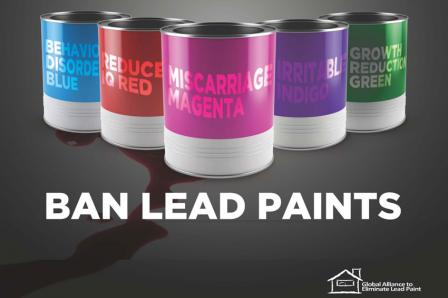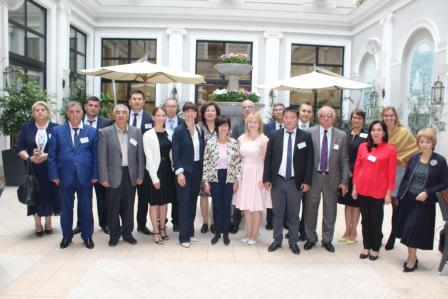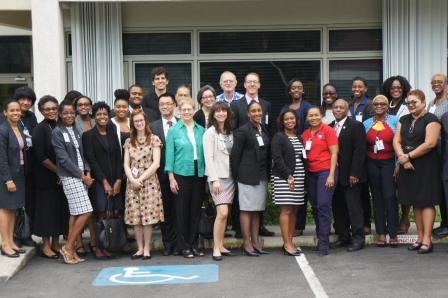EPA Leadership in the Lead Paint Alliance

The Global Alliance to Eliminate Lead Paint ("Lead Paint Alliance" or "the Alliance") is a voluntary collaborative partnership of governments, private industry, and NGOs that works to promote the phase-out of the use of lead in paint. The Lead Paint Alliance was established in 2011 and the United Nations Environment Programme (UNEP) and the World Health Organization (WHO) serve as the joint secretariat. U.S. EPA is currently the chair of the Lead Paint Alliance.
The main objective of the Alliance is to prevent children’s exposure to lead via paints containing lead, particularly those in countries where lead paint is still manufactured and is commonly used. The goal of the Lead Paint Alliance is to promote the establishment of lead paint laws globally. The U.S. banned lead in paint in the 1970s and is providing technical and policy expertise to developing countries to put in place lead paint laws. Governments, private industries, and NGOs can support this goal by becoming a partner of the Lead Paint Alliance.
Resources:
- Visit the official website of the Lead Paint Alliance. Exit
- 2019 Global Status Update of Lead Paint Laws Exit
- Suggested Steps For Establishing a Lead Paint Law Exit
- Model Law and Guidance for Regulating Lead PaintExit
- Toolkit for Establishing Laws to Control the Use of Lead in Paint Exit
- Guidance on advocacy and awareness-raisingExit
- Policy Brief and Technical Brief on Global elimination of lead paint: why and how countries should take actionExit
- Updated WHO Brief guide to analytical methods for measuring lead in paintExit
- Become a partner of the Lead Paint AllianceExit
- Tracking Status of Laws, Paints and Impacts:
- Database of regulations and controls on lead paint (from WHO)Exit
- Interactive visualisation of the status of lead paint laws (from UNEP) Exit
- Map of Lead Levels in Paint Around the World (from Lead Paint Alliance partner IPEN) Exit
- Interactive map of economic costs from New York University: Economic Costs of Childhood Lead Exposure in Low and Middle Income Countries Exit
- Lead in Paint Community of Practice (1 p, 919 K, About PDF) Exit
- Videos:
- Lead Paint Alliance: Ban Lead Paint Exit
- Strategic Approach to International Chemicals Management (SAICM): Lead in Paint: Emerging Policy Issue Exit
Highlights
 EPA participated in a Department of Commerce-sponsored Sub-Regional Workshop on Lead Paint Elimination in Central Asia and Eastern Europe in Tbilisi, Georgia on September 11-12, 2019. October 2020: The 8th annual International Lead Poisoning Prevention Week of Action will take place October 25 -31, 2020. EPA will join the World Health Organization (WHO), the United Nations Environment Program (UNEP) and other organizations around the world to promote banning lead paint and to raise awareness of the activities of the Lead Paint Alliance.
EPA participated in a Department of Commerce-sponsored Sub-Regional Workshop on Lead Paint Elimination in Central Asia and Eastern Europe in Tbilisi, Georgia on September 11-12, 2019. October 2020: The 8th annual International Lead Poisoning Prevention Week of Action will take place October 25 -31, 2020. EPA will join the World Health Organization (WHO), the United Nations Environment Program (UNEP) and other organizations around the world to promote banning lead paint and to raise awareness of the activities of the Lead Paint Alliance. - Learn more about the 2020 International Lead Poisoning Prevention Week of Action.
- Official website: International lead poisoning prevention week of action.Exit
September 2019: EPA participated in a Department of Commerce-sponsored Lead Paint Elimination Workshop for the Central and Eastern Europe and Central Asian Region in Tbilisi, Georgia on September 11-12, 2019. The workshop sought to assist target countries in this region in developing national and regional laws on lead paint. The workshop was attended by the UN Environment Program, the World Health Organization and the American Bar Association Rule of Law Initiative, as well as NGOs from several countries in the region.
March - August 2019: EPA participated in four regional lead paint workshops organized by UN Environment as part of the Lead in Paint component of the SAICM Global Environment Facility (GEF) project Exit“Global best practices on emerging chemical policy issues of concern under the Strategic Approach to International Chemicals Management (SAICM).”
- Asia Pacific Regional Lead Paint Workshop in Bangkok, Thailand, August 21-22
- Latin America and the Caribbean Regional Workshop on Lead Paint in Panama City, Panama, June 12-13, 2019
- Africa Regional Workshop on Lead Paint in Abidjan, Cote d’Ivoire, May 28-29, 2019
- Central and Eastern Europe Regional Workshop in Lead Paint in Almaty, Kazakhstan, March 19-20, 2019
The workshops were attended by country representatives in each region, as well as Lead Paint Alliance partners EPA, the World Health Organization, the American Bar Association Rule of Law Initiative (ABA-ROLI), environmental NGOs and industry representatives. Follow up to the workshops includes identification of steps in each country to establish lead paint laws.
Meeting reports and presentations from each workshop Exitare available on the website of the SAICM GEF project.
December 2017: Environment ministers from around the world signaled support of lead paint laws by passing a lead paint resolution at the Third United Nations Environment Assembly (UNEA-3).
 EPA participated in the Caribbean Workshop on the Establishment of Legal Limits on Lead in Paint, which had 38 attendees, representing more than 20 organizations and agencies from the public, private, and civil sectors.
EPA participated in the Caribbean Workshop on the Establishment of Legal Limits on Lead in Paint, which had 38 attendees, representing more than 20 organizations and agencies from the public, private, and civil sectors.August 2017: The American Bar Association passed a resolution to promote lead paint laws globally, urging its members to support adoption and implementation of laws to phase out and eliminate lead paint through pro bono support, educational initiatives, and other appropriate means.
May 2017: At the 40th World Health Assembly, health ministers approved action on lead paint in a Chemicals Roadmap. Exit
About Lead Paint

Lead exposure is a well-known source of injury to human health, particularly to the health of children and to workers in lead industries. No level of exposure to lead is considered safe. Children exposed to high levels of lead may experience sensory, motor, cognitive and behavioral impacts, including learning disabilities; attention deficits; disorders in coordination, visual, spatial and language skills; and anemia.
Using leaded paint creates potential lead poisoning problems for the future. Most poisoning from lead paint occurs when infants and children ingest the dust of old lead paint as it deteriorates of chips off surfaces. Thus, lead paint poses a health risk long after the initial painting is done. That is why we want to work together to make sure that no paints contain lead.
Alternatives to lead paint already exist. Although lead paint is still produced and sold in many countries around the world, a simple, cost-effective alternative exists. Paints without added lead are as effective and economically competitive as their lead counterparts. In fact, a nine-country study published by UNEP and the NGO IPEN Exitshowed that in many places where lead paint is sold, lead free alternatives exist for similar prices. Recent paint testing (52 pp, 3M, About PDF)Exitalso shows that paints with low levels of lead are available in developing countries.
About the Lead Paint Alliance
The U.S. EPA is an active member, and Advisory Group Chair, of the Global Alliance to Eliminate Lead Paint Exit. The Lead Paint Alliance is a global partnership of Governments, private industry, and NGOs that works to promote the phase-out of the use of lead in paint.
The work of the Lead Paint Alliance includes raising awareness of the dangers lead poisoning poses to human health; and helping developing countries build regulations to stop the manufacture, import, sale and use of paints containing lead.
The Lead Paint Alliance is promoting the establishment of lead paint laws globally partially through the Lead in Paint component of the SAICM Global Environment Facility (GEF) project Exit“Global best practices on emerging chemical policy issues of concern under the Strategic Approach to International Chemicals Management (SAICM)." This project is working with governments to help establish laws and with industry to help promote reformulation of lead paint.
As Chair of the Lead Paint Alliance Advisory Group, U.S. EPA is working to help make other nations aware of the dangers of lead paint and ways to address this problem. The Global Alliance is focusing its efforts on helping countries without existing lead paint laws put effective legislation/regulations in place.
The Alliance is a led by a joint secretariat of the United Nations Environment Programme (UNEP) Exitand the World Health Organization (WHO).Exit It was established at the International Conference on Chemicals Management at its second session (ICCM2) as one initiative to implement the Strategic Approach to International Chemicals Management (SAICM). Exit
This initiative promotes the implementation of paragraph 57 of the Plan of Implementation of the 2002 World Summit on Sustainable Development (PDF) Exit, which states: to phase out lead in lead-based paint and in other sources of human exposure, work to prevent, in particular, childrens exposure to lead and strengthen monitoring and surveillance efforts and the treatment of lead poisoning.
Useful Links
- EPA's Actions on Lead
- National Lead Poisoning Prevention Week
- International Lead Poisoning Prevent Week of Action Exit (hosted by the World Health Organization) Exit
- Model Law and Guidance for Regulating Lead Paint Exit
- UNEP Global Status Update on Lead Paint Laws: September 2019 Exit
- UNEA3 Resolution on Lead Paint Exit
- World Health Assembly Chemicals Roadmap Exit
- ABA Resolution and Report on Lead Paint (19 pp, 350 K, About PDF) Exit
- Toolkit for Establishing Laws to Control the Use of Lead in Paint Exit
- Global Alliance to Eliminate Lead Paint Exit
- United Nations Environment Programme (UNEP) Exit
- Plan of Implementation of the 2002 World Summit on Sustainable Development (PDF) Exit
- Strategic Approach to International Chemicals Management (SAICM) Exit
Contacts
For additional information on EPA's work with the Lead Paint Alliance, contact:
Angela Bandemehr
U.S. Environmental Protection Agency
Office of International and Tribal Affairs (2670R)
1200 Pennsylvania Ave., NW
Washington, DC 20460
E-mail: bandemehr.angela@epa.gov
(202) 564-1427
